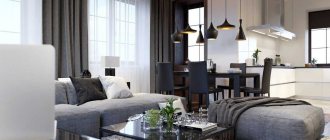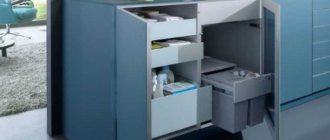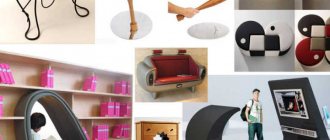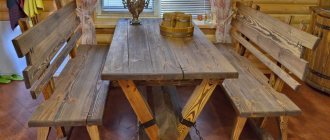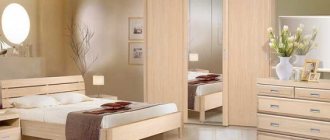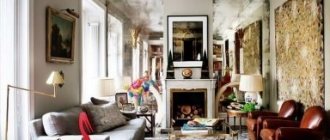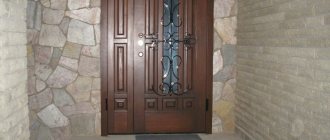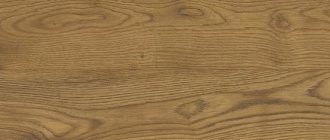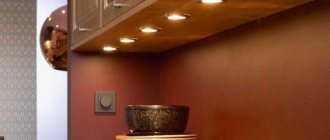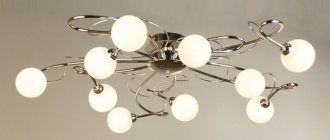Upholstered furniture is an integral part of the interior of many rooms. In the standard version, it is covered with special types of textiles, but leather upholstery is much more popular. Armchairs and sofas in this design look especially presentable and noble. Most often, artificial leather is used for furniture, since the high cost of natural material makes it inaccessible to a wide range of consumers. Meanwhile, the synthetic analogue looks no less attractive, and in some respects even surpasses natural raw materials.
What is
Faux leather is a polymer fabric that imitates natural material. Its structure is represented by several layers:
- knitted base;
- non-woven material;
- impregnating composition;
- polymer finish.
The entire production process of leatherette consists of three main stages:
- preparation of the fibrous base;
- polymer coating treatment;
- finishing.
At the first stage, a suitable fibrous base is selected. For this purpose, knitwear, paper, fabrics, as well as non-woven materials of natural or artificial origin are used. The future characteristics of the leather depend on the type of base: stretchability, strength, drapery. To increase strength characteristics, at the second stage of production it is coated with a special composition, which is obtained from molten substances, solutions, and polymers.
To improve the properties of the material, increase strength and frost resistance, special mixtures are added to the polymer.
To ensure that the composition is applied evenly to the base, specialized equipment is used. The polymer can be used to coat only the outer surface of the base or to process it all the way through. Most often, in the process of producing artificial leather, these two methods are combined.
The porous structure of leatherette is achieved by perforation, chemical or mechanical foaming, and separation of polymers. At the final stage, artificial leather for furniture is given any desired shade, sanded, varnished, patterned, matted. The finished material can imitate natural textures, suede.
Upholstery for a sofa "matting": pros and cons
The modern market for upholstered furniture is a variety of shapes, colors, textures. Sofas, as one of the most popular pieces of furniture, are no exception.
When purchasing, it is important to consider not only the appearance of the sofa, but also its functionality and ease of use . Upholstery fabric is one of the important nuances that you need to pay attention to. This is both the “face” of the furniture and a sign of quality, which determines how long the sofa will last.
For those who value practicality and stylish appearance, matting upholstery will be an excellent choice.
Advantages and disadvantages
Furniture leatherette, like any other material, is characterized by a number of features. Among them there are certain advantages and some disadvantages. The advantages include:
- wear resistance - the original appearance of leatherette products is preserved for a long period of operation;
- higher strength compared to its natural counterpart;
- frost resistance;
- elasticity;
- ease of cleaning;
- maintaining color saturation even under the influence of sunlight;
- hypoallergenic, no unpleasant odors;
- affordable price;
- wide range of colors.
Models of cardboard furniture, selection and preparation of raw materials for its manufacture
However, synthetic material also has disadvantages:
- at high temperatures it is subject to deformation, at low temperatures cracks may appear;
- insufficient breathability;
- light-colored fabrics may become stained upon contact with colored items;
- budget options may have a chemical smell;
- tendency to ignite near open sources of fire;
- To preserve the appearance and performance, timely treatment with special means is required.
Leatherette, unlike its natural counterpart, can become deformed during prolonged contact with water. Small defects are eliminated using a high-strength polymer - liquid leather for furniture.
Wear resistance
Elasticity
Frost resistance
Easy to clean
Hypoallergenic
Large assortment of colors
Description of chenille
Read about: chair covers - a tribute to fashion or a necessary accessory
As in the case of jacquard, chenille is not the material itself, but the yarn from which it is woven. Materials with chenille thread are strong, durable, pleasant to the touch and look beautiful. The main advantage of sofa upholstery is the huge number of color and texture options. The characteristics of the fabric provide mainly positive customer reviews.
Types of leatherette
Thanks to modern technologies, artificial leather is not only in many ways similar to natural leather, but in some cases even surpasses it. Leatherette is divided into several categories. The basis is the type of polymer included in the material. Among the most popular varieties:
- polyvinyl chloride;
- polyurethane;
- eco leather;
- stretch leather;
- granitol;
- microfiber.
PVC leatherette is one of the most popular types of raw materials in the manufacture of furniture. Among the other components, it contains a special plasticizer. The base consists of knitted and non-woven materials. To increase elasticity, synthetic components are added to it. PVC leatherette is resistant to sunlight and mold, durable, and easy to care for.
One of the best materials of the new generation is PU leatherette. It is characterized by the presence of polyurethane (a high-grade polymer) in its composition, which imitates the structure of natural raw materials. The material consists of three layers:
- cotton base;
- pre-treated genuine leather with defects;
- high quality polymer.
Advantages of MDF furniture, features of operation and care
Thanks to polyurethane, the material is characterized by increased strength, frost resistance, elasticity, softness, a variety of colors, as well as the presence of patterns and prints. The porous structure promotes good breathability and moisture-repellent properties.
Eco-leather is similar in many respects to PU leatherette. The main difference is the absence of a second layer in the composition. The base of cotton fabric and synthetic fibers is coated with a polymer, thanks to which the material is characterized by similar advantages.
The absence of PVC in eco-leather eliminates the occurrence of allergic reactions.
Stretch leather is made by applying a polymer coating to textiles, most often elastane, on one or both sides. Granitol (or leatherette) consists of cotton fabric coated on one or both sides with a nitrocellulose layer. Microfiber is characterized by softness, strength, and elasticity due to the presence of polyamide or polyester fibers. The material is resistant to both physical and chemical factors and retains its color for a long time.
Polyvinyl chloride
Polyurethane
Eco leather
Stretch leather
Granitol
Microfiber
Video material
Before purchasing, do not be lazy to read reviews about manufacturers and inquire about the technologies used. In stores you can find many similar models made from the same materials. But some become unusable within a year, others serve faithfully for decades. While still in the store, do not forget to check the build quality of the structure, seam connections and the integrity of the fabric. Also, inquire about the manufacturing method and ask for certificates if you are planning to buy furniture made from genuine leather.
How to distinguish artificial material from natural
Furniture leatherette is very similar in appearance to natural leather due to such qualities as environmental friendliness, breathability, and the ability to repel moisture. Every year, manufacturers manage to increasingly reduce the differences, improving the external characteristics and quality indicators of the synthetic analogue. Thus, it can be difficult for the average person to distinguish leatherette from natural raw materials, this serves as a reason for deceiving buyers. But some signs still reveal the true origin of the fabric:
- The edge of leatherette is smooth, while that of genuine leather is rough.
- If you put your hand on the furniture, the natural material at the point of contact will quickly become warm, while remaining dry. The artificial leather will take longer to heat up and your palm will become damp.
- If you press on an artificial analogue or bend it, the surface will not immediately return to its original form.
- The fold on the surface of leatherette is more angular, in addition, in this place the material changes color to a lighter one.
- Some types of synthetic raw materials give off a noticeable chemical odor.
- If you drop a little water on the material, the natural base will gradually absorb moisture, and the water will drain from the artificial raw material, leaving the surface dry.
- Under the influence of fire, leatherette melts, natural leather gradually deforms, emitting the smell of burnt hair.
Furniture with leather upholstery must be accompanied by appropriate documentation confirming the quality of the materials used. It usually reflects what raw materials were used - natural or synthetic.
Genuine leather has a rough edge
Pores on natural leather are located chaotically
Genuine leather does not stretch well, but it does so equally in any direction.
Natural material does not melt and does not emit pungent odors when burning
Leatherette does not absorb moisture
How to choose?
If all the pros and cons of upholstering a sofa with faux leather have been weighed and a decision has been made to purchase it, one more important question remains - the functionality of the furniture. The choice of material also depends on where the sofa or chair will be placed and how often it will be used:
- For an office or other office premises, it is better to choose a completely smooth surface of the material so that it is easier to wash and clean from dirt.
- But for a home where a small number of people use furniture, you can choose embossed leatherette or genuine leather. Such materials look much more interesting, and it will be more comfortable to sleep on such a surface.
Important! The strength of the material is of great importance both for the choice of office and home furniture. A very dense and thick base will look a little rough. This option may not be entirely suitable for a home, but for a workplace, cafe or restaurant it would be quite appropriate.
Rules of care
Furniture is subject to constant mechanical stress during operation. To maintain the attractiveness of its appearance, you should adhere to simple rules:
- To remove stains, use wet wipes with a soap solution. Wipe the cleaned surface dry.
- Place leatherette furniture at a safe distance from fire and hot springs to prevent ignition and deformation of the material.
- Regularly clean the surface of the sofa or armchairs with a vacuum cleaner, but do not use hard brushes, otherwise you can damage the decorative layer.
- Treat products with natural leather impregnations to preserve their original appearance for a long time.
- To remove stains, use ammonia.
Benefits of leather furniture, tips for arranging and caring for it
To clean furniture from dust, it is recommended to use microfiber cloths lightly moistened with water. After wet cleaning, the product should always be wiped dry. It happens that cracks form on the surface. In this case, liquid leather is used for furniture.
In order to give the repaired area a porous appearance after treatment with liquid leather for furniture, you need to attach a piece of material of a suitable texture to it and press it for a few seconds.
A wide range of leatherette furniture allows you to select high quality material at an affordable cost. It makes no sense to spend a lot of money on natural upholstery when the synthetic analogue is not much inferior to it in terms of basic characteristics. The main thing is to properly care for leatherette furniture in order to preserve its noble appearance for a long time.
To remove stains, use a cloth soaked in soapy water.
Do not place furniture near sources of heat or fire
Regularly clean the surface with a vacuum cleaner with a special attachment.
Treat with impregnations for natural leather
To remove complex stains, use ammonia
Varieties
Modern manufacturers offer a wide selection of leather for furniture, both natural and artificial. The type of leather upholstery depends on the material and production technology. For the production of natural furniture leather, the skins of cattle are used. During the manufacturing process, the skins are divided into several layers. The top layer is the highest quality and thickest and is used for upholstering expensive furniture. It has softness, elasticity, the required thickness, and is therefore durable. The bottom layer is of lower quality and durable, called split leather, used for various purposes: the production of haberdashery, shoes, clothing, furniture leather.
Genuine furniture leather is divided according to the tanning method:
- processing with natural plant ingredients;
- chrome treatment;
- without treatment, with the application of a protective dust coating of wax, resin or paint.
Depending on the tanning method and additional processing, the following types of leather for upholstery are distinguished:
- crust – dense, durable genuine leather with the natural face preserved. During use, natural abrasions and color darkening occur;
- smooth leather for furniture - flexible and soft, without processing the front surface. Made from the skins of young animals. Used for upholstery of luxury furniture, production of expensive accessories, clothing, shoes;
- aniline - a type of smooth leather, belongs to premium materials, with the application of a protective coating that preserves the natural texture on the front surface;
- semi-aniline – has additional protective coatings, making it more resistant to external influences;
- velor and suede - have a velvety surface, require careful care and additional processing;
- nubuck – dense, with a refined velvety surface, also requires additional care using special products;
- crazy – has a matte surface with a special wax coating.
Aniline
Smooth
Crust
Nubuck
Crazy
Today, manufacturers offer many high-quality substitutes for natural upholstery. Modern artificial leather coverings are not inferior in quality to natural materials, and furniture in artificial leather is visually difficult to distinguish from natural ones.
Among modern artificial furniture upholstery, the following stand out:
- microfiber – has the softness of natural material, but does not absorb foreign odors, is not abrasion-resistant, wear-resistant, retains color and shape when exposed to light and high temperatures;
- vinyl artificial leather - based on polyvinyl chloride applied to a fabric surface. Special impregnations provide strength and wear resistance to vinyl leather substitute;
- leather substitute - based on polyurethane applied to a fabric base. An excellent modern analogue of a natural product, possessing all its advantages, but excluding its disadvantages.
Vinyl leather
Microfiber
Which is better - chenille, flock, velor, matting, jacquard or tapestry
When creating products, you can use any of these materials and even their weaves.
You might be interested in this: The best options for beautifully hanging tulle on windows
Jacquard is more suitable for connoisseurs of originality. Beautiful ornaments combined with a pleasant, velvety material can create an exquisite piece.
Matting is a dense fabric. The difference between it and chenille lies in the texture and tactile characteristics.
Note: Matting is inherently rough. Pets love to sharpen their claws on this material, so it is not suitable for cat owners.
Tapestry is cleaner and safer for people, since its composition is predominantly represented by natural ingredients. Despite its many advantages, the fabric wears out easily and its design is erased.
Couch
Flock is a vandal-proof, popular material in the consumer market. Its main advantage over its competitors is its durability. It is multifunctional and suitable for creating a variety of products. It is very difficult to break, so it gets along well with pets.
Velor is a delicate material, prone to dirt and abrasion. Bed tones look elegant in the living room or bedroom, but you need to be prepared that the products will not last long.
Furniture chenille: current design and fashionable colors
At the moment, this type of fabric is on the list of the most relevant, stylish and expensive materials. Production technologies allow us to create unique, original colors.
Curtains
Now the trend is chenille for furniture with:
- Solid colors, burgundy is especially popular.
- Abstract drawings.
- Damask patterns on light, cream backgrounds.
- Geometric motifs.
You might be interested in Which fabrics are best to choose for roller blinds and light curtains
Fabric with abstract patterns
